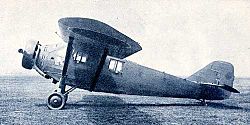Mitsubishi K3M
| K3M | |
|---|---|

|
|
| Type: | Radio and navigation trainer aircraft |
| Design country: | |
| Manufacturer: | |
| First flight: |
May 1930 |
| Number of pieces: |
624 |
The Mitsubishi K3M ( Japanese九 〇 式 機 上 作業 練習 機, Kyūrei-shiki kijō sagyō renshūki, literally "Jiufen type training device") is a military training aircraft made by the Japanese manufacturer Mitsubishi Kōkūki .
history
During the First World War , the Japanese Empire learned to appreciate the advantages of air forces . Therefore, the Imperial Japanese Armed Forces built their own air force in the interwar period based on foreign constructions and developments, which, however, massively increased the already existing dependence on other countries until the mid-1930s. After the Japanese Air Force grew in size and confidence, they encouraged Japanese companies to develop and build aircraft themselves. The Imperial Japanese Navy commissioned Mitsubishi to build a training aircraft . Mitsubishi then hired British engineer Herbert Smith to design the aircraft. Smith began his work in 1928 but soon abandoned the project. In 1929 Joji Hattori took over the development work and in May 1930 Hattori's construction completed its maiden flight . After implementing some change requests, the Navy ordered the aircraft in larger quantities. A total of about 624 copies were built. Although the K3M was originally designed as a training aircraft, it was also used as a light liaison aircraft during the Pacific War .
construction
The K3M was a single-engine, braced high-wing aircraft with a fuselage made of a fabric-covered metal frame . The machine had two open cockpits for the pilot and the gunner and a closed cabin for the flight instructor and two students. The four prototypes were powered by a Hispano Suiza V8 engine with a nominal output of 340 hp (250 kW), which Mitsubishi built itself. In contrast to the first two prototypes, the wings of the third and fourth prototypes had a V-position , which improved the flight stability of the machine.
Versions
- K3M1
- Name of the four prototypes
- K3M2
- First built in series version, powered by a Hitachi Amakaze-11 - radial engine of 340 hp (250 kW ); 70 copies of Mitsubishi, 247 more by Aichi Tokei Denki built
- K3M3
- Last version built in series with enlarged tail unit , powered by a Nakajima Kotobuki -2 with 580 HP (427 kW); 301 copies were built by Watanabe Tekkōjo
- K3M3-L
- Variant of the K3M3 for the transport of five passengers or light cargo
- Ki-7
- Name of two prototypes that were planned for the Imperial Japanese Army but never built
operator
Technical specifications
| Parameter | Data |
|---|---|
| crew | 4th |
| Passengers | 6th |
| length | 9.54 m |
| span | 15.78 m |
| height | 3.82 m |
| Wing area | 34.5 m² |
| Empty mass | 1360 kg |
| Max. Takeoff mass | 2200 kg |
| Top speed | 230 km / h (124 kn ) |
| Service ceiling | 6,400 m (20,997 ft ) |
| Range | 790 km |
| Engine | 1 × Nakajima Kotobuki -2 with 580 PS (427 kW ) |
| Armament | 1 × 92 type machine gun, 7.7 mm at the rear, 4 × 30 kg bombs |
Comparable types
See also
literature
- René J. Francillon: Japanese Aircraft of the Pacific War . Putnam & Company Ltd, London 1979, ISBN 0-370-30251-6 (English).
- Robert C. Mikesh, Shorzoe Abe: Japanese Aircraft, 1910-1941 . Naval Institute Press, Annapolis, Maryland 1990, ISBN 1-55750-563-2 (English).
Web links
Individual evidence
- ↑ a b c d Justin D. Murphy, Matthew A. McNiece: Military Aircraft, 1919-1945: An Illustrated History of Their Impact . ABC-CLIO, 2009, ISBN 978-1-85109-498-1 , pp. 185, 186 (English, google.de ).
- ↑ Kenneth Munson: The World War II Planes . 1st edition. Motorbuch Verlag, Stuttgart 1973, ISBN 3-87943-302-X , p. 351, 352 .
- ↑ a b c d e f g John Rickard: Mitsubishi K3M 'Pine'. Military History Encyclopedia on the Web, July 25, 2011, accessed March 13, 2020 .
